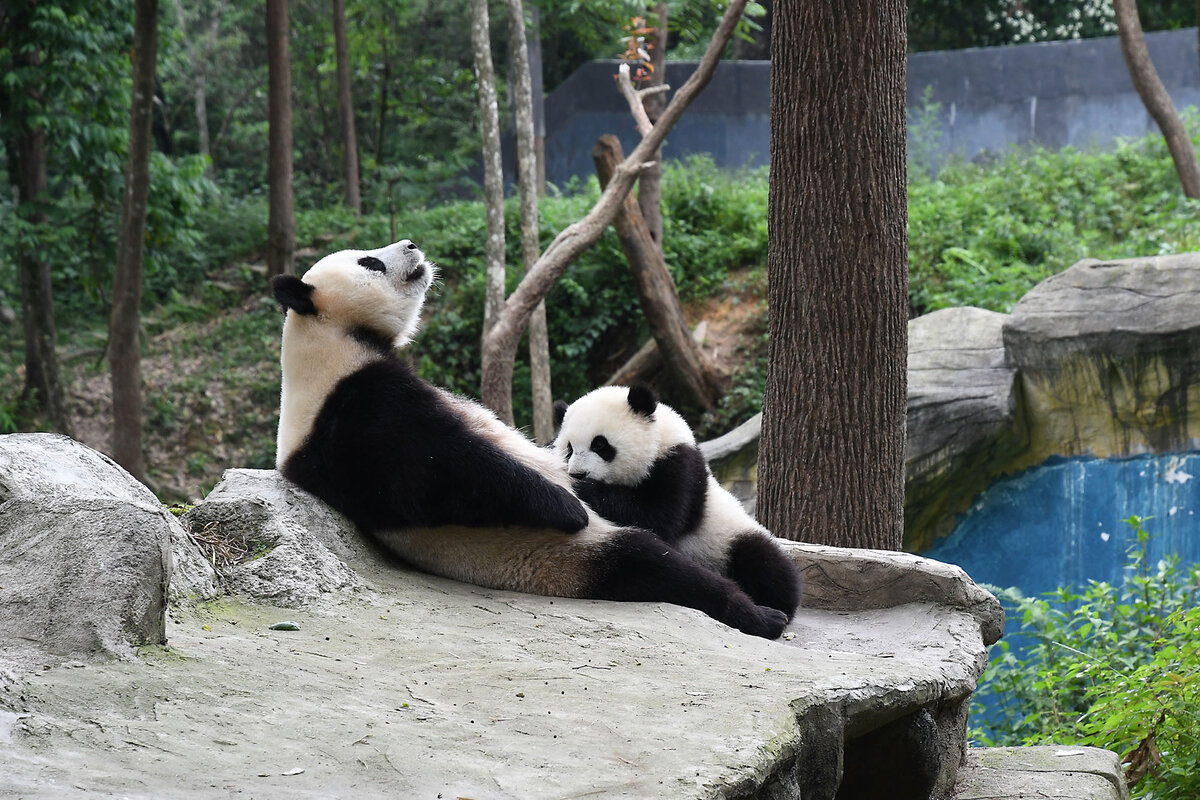Pandas on a mission: China sends furry envoys to boost US ties – and aid conservation
Loading...
| Bifengxia Base, Ya’an, China
In the lush mountains of China’s western Sichuan province, deep in bamboo-covered forests, the new mission was a closely guarded secret.
Life went on for the team with seeming tranquility – munching bamboo, climbing trees, and sleeping on wooden platforms under thatch-roofed huts. But amid the quiet daily routines, hushed preparations were underway.
“I don’t know the concrete time – but we are getting ready,” Huang Zhi, director of the Ya’an Bifengxia base of the China Conservation and Research Center for the Giant Panda, told The Christian Science Monitor in June.
Why We Wrote This
The return of pandas to the United States is sparking a new wave of “panda-monium,” highlighting the bears’ enduring power to shape China’s foreign relations and global wildlife conservation.
Then came the word, late last month – it was a go.
Two rare giant pandas jetted off from Bifengxia base to California, the first pair of panda envoys to the United States in 21 years. Feted in a send-off by American and Chinese dignitaries and accompanied by an entourage from both countries, the young VIPs, Yun Chuan and Xin Bao, are now settling in to their official quarters at the San Diego Zoo, priming for their debut public appearance.
Indeed, despite serious U.S.-China tensions, panda diplomacy is alive and well. These furry emissaries were dispatched after Chinese leader Xi Jinping suggested panda cooperation should continue during a November visit to California, where he met with U.S. President Joe Biden, and more are on the way. China’s use of panda diplomacy dates back to the 1940s, and in recent decades, the bears’ mission has expanded – from envoys of peace and friendship to wildlife and conservation ambassadors.
China is “now using the panda diplomacy as a way to underscore their commitment to conservation and the environment,” says Barbara Bodine, distinguished professor in the practice of diplomacy at Georgetown University and a former senior U.S. diplomat. “Pandas are now kind of a twofer,” she says.
History of China’s panda diplomacy
Pandas have roamed eastern Asia for millions of years, but the iconic black-and-white bears first captured the hearts of the American public in 1936, when a wealthy U.S. adventurer brought a baby panda back from China and put it on exhibit. With its unique black-fur-ringed eyes, signature waddle, and sixth digit that lets it hold food in a humanlike way, the bear’s cuteness unleashed what was dubbed “panda-monium.”
The unthreatening, cuddly bears soon emerged as the choice to represent China on the world stage. In 1941, Chiang Kai-shek, ruler of Republican China, first gave pandas to the U.S. in thanks for Washington’s support of Chinese refugees during the war with Japan. Communist Party leader Mao Zedong gifted two more pandas to U.S. President Richard Nixon during his historic China trip in 1972.
“It’s a brilliant use of animal diplomacy,” says Ambassador Bodine.
To be sure, she says, “The issues between China and U.S. are not resolved when we get two oversized plush toys.” But the wildly popular pandas certainly don’t hurt.
And the bears are more than mere symbols. Panda power is fueling tangible conservation work and partnerships between China and the U.S., and around the world.
While some have accused the charismatic bears of drawing attention and resources away from other critical species, experts say it’s not a zero-sum game. Protection of panda habitat – some 5 million acres of bamboo-rich forests in western China – is also helping thousands of other animal and plant species survive, including the red panda, golden monkey, and snow leopard, says Fu Mingxia, deputy director of the Management and Protection Center of Daxiangling Nature Reserve, Yingjing County in Ya’an.
And of course, pandas themselves have benefited greatly. Their population in the wild grew by several hundred since the 1980s, reaching more than 1,800 in 2015 – progress that led the International Union for the Conservation of Nature to downgrade their risk status from “endangered” to “vulnerable.” Another nearly 700 pandas live in zoos and breeding centers worldwide.
In giant panda research centers in Ya’an, scientists from China, the U.S., and other countries are studying panda biology, breeding, and reproduction. Some 11 pandas bred in captivity were introduced into the wild between 2005 to 2018 and are believed to have survived for at least two years, the life span of tracking devices.
Overall, preventing habitat destruction by logging, farming, and other development has contributed most to the pandas’ improved prospects. China is preparing to conduct another wild panda census next year, and expects to find the population has grown, Mr. Huang says.
The panda cause has raised awareness worldwide about the need to protect endangered species. In 1961, the World Wildlife Fund chose Chi-chi, a panda at the London Zoo, as the model for the WWF logo.
Pandas “can raise everyone’s awareness of environmental protection,” says Zhang Hemin, chief expert at the China Conservation and Research Center for the Giant Panda, who has researched pandas for 41 years. “Pandas belong to the whole world.”
A thriving “pandeconomy”
Wherever they are, pandas bring donations for conservation efforts, as well as economic opportunities from tourism and retail sales.
In Washington, the Smithsonian’s National Zoo is awaiting new panda cubs Bao Li and Qing Bao later this year, filling a void left in 2023 when the zoo had to send its last three pandas back to China after 50 years of hosting the animals. The flurry of excitement is helping the zoo advance its goal of raising $25 million for pandas and conservation, while also stimulating business nearby – a phenomenon dubbed the “pandeconomy” in local news reports.
In San Diego, residents are eagerly awaiting a chance to see Yun Chuan, a 5-year-old male whose mother was born at the San Diego Zoo in 2007, along with Xin Bao, a 4-year-old female called “gentle and well-behaved” by the official Chinese media.
In western Sichuan, pandas attract significant tourism revenues, which translates into jobs for some of the thousands of villagers who were relocated out of panda habitats.
Many villagers in Ya’an go out of their way to protect the pandas – calling for rescues if they come across pandas who appear injured or ill.
Rescuer Zheng Congjun patrols year-round high in Ya’an’s mountains looking for signs of pandas, and has spotted 13 in the wild over his 30 years in the field.
“Once a family found a panda in a tree. They thought it was hurt, so they used bedding, sheets, and rope to make a giant net in case the panda fell,” says Mr. Zheng, director of the Giant Panda Education Center in Baoxing County. “From this, I knew the local people loved the pandas. I love them, too.”
Unhurt, the panda returned safely to the wild.










